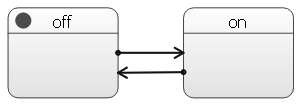双向按钮范例展示如何使用 Qt State Machine Framework 以实现简单状态机切换当前状态当点击按钮时。

int main(int argc, char **argv) { QApplication app(argc, argv); QPushButton button; QStateMachine machine;
The application's main() function begins by constructing the application object, a button and a state machine.
QState *off = new QState();
off->assignProperty(&button, "text", "Off");
off->setObjectName("off");
QState *on = new QState();
on->setObjectName("on");
on->assignProperty(&button, "text", "On");

The state machine has two states;
on
and
off
. When either state is entered, the text of the button will be set accordingly.
off->addTransition(&button, &QAbstractButton::clicked, on);
on->addTransition(&button, &QAbstractButton::clicked, off);
When the state machine is in the
off
state and the button is clicked, it will transition to the
on
state; when the state machine is in the
on
state and the button is clicked, it will transition to the
off
状态。
machine.addState(off);
machine.addState(on);
The states are added to the state machine; they become top-level (sibling) states.
machine.setInitialState(off);
machine.start();
The initial state is
off
; this is the state the state machine will immediately transition to once the state machine is started.
button.resize(100, 50);
button.show();
return app.exec();
}
Finally, the button is resized and made visible, and the application event loop is entered.